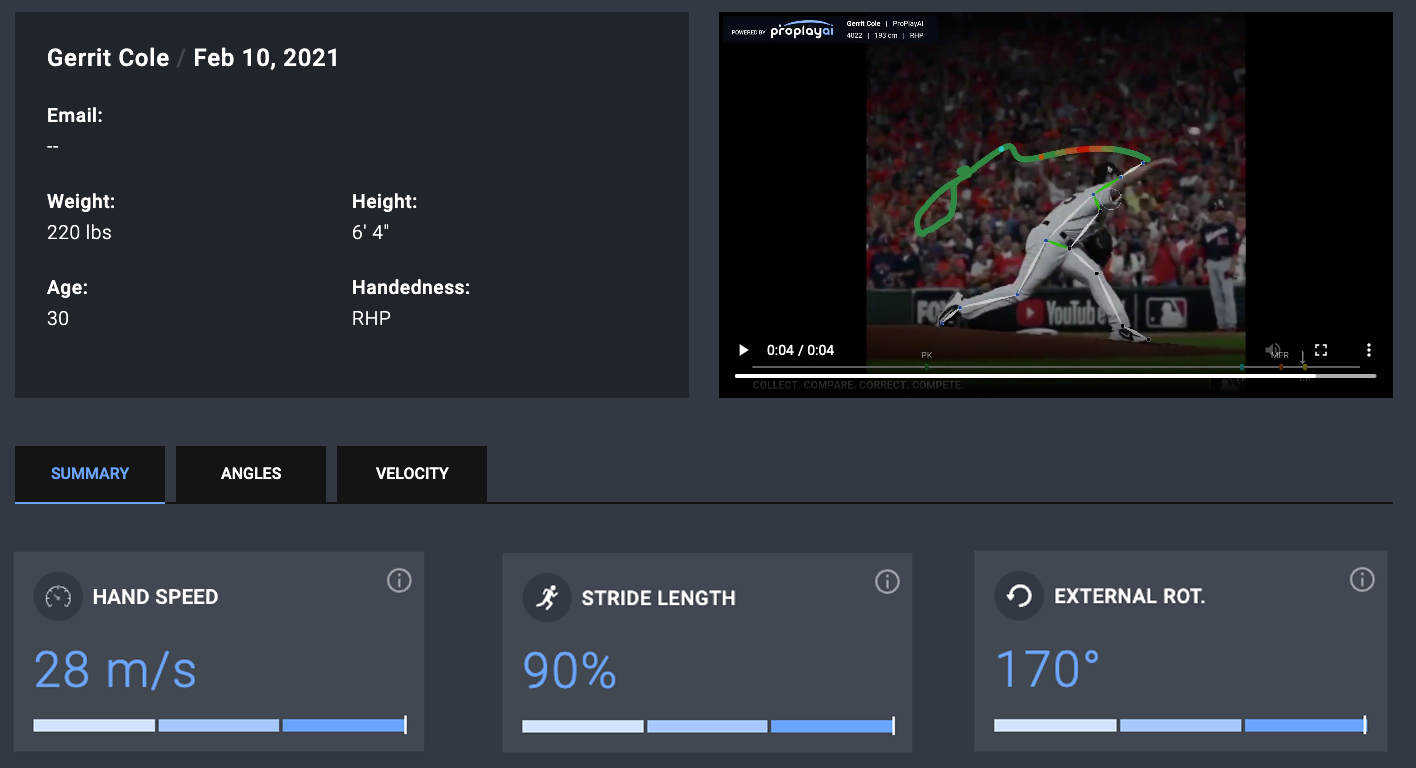Introduction to
Biomechanics Using PitchAI
Colin McKinnon, PhD / Elora Brenneman Wilson, PhD
Basic Metrics
The first three metrics that we are going to cover are Stride Length, External Rotation, and Hand Speed. These metrics can be viewed very simply – a higher value is associated with higher velocity. Specifically, a greater stride length is related to pitchers that throw harder, greater external rotation means greater range of motion, and greater hand speed means higher velocity.
On the overview tab, click the dropdown and select the metric you want to see. In general, each of the metrics is going to show you a blue graph that goes from light blue to dark blue. This compares the pitch performance against our database of athletes. A line that shows up on the right side of the graph means that your value is higher than the average athlete. A line on the left side of the graph means your value is lower; right in the middle is average. Keep in mind, this database consists of only elite athletes at the moment.

On the overview tab, click the dropdown and select the metric you want to see. In general, each of the metrics is going to show you a blue graph that goes from light blue to dark blue. This compares the pitch performance against our database of athletes. A line that shows up on the right side of the graph means that your value is higher than the average athlete. A line on the left side of the graph means your value is lower; right in the middle is average. Keep in mind, this database consists of only elite athletes at the moment.
Stride Length is how far the pitcher steps forward and down the mound, in units of % of their total height.
Looking at this report from Gerrit Cole, we can see that his Stride Length is roughly 90% of his height. Compared against our database, he’s in the upper third of all pitches. This is something we would expect from an elite pitcher like Cole. We know that pitchers who have a longer stride typically throw harder – something to consider when you’re evaluating your athletes.
External Rotation is the “lay back”, or how far the shoulder rotates backwards prior to releasing the ball. This is a good measure of the pitcher’s shoulder flexibility, and research has illustrated greater external rotation is associated with higher pitching velocities. Cole’s external rotation once again falls into the upper third of all of our athletes. Having the arm be able to lay back, or externally rotate more, gives the athlete more space to accelerate the arm and generate greater hand speed. While it is important to have greater lay back, it’s essentially in place to help generate more hand speed, and show the pitcher is able to move their arm effectively to throw a baseball at maximum intensity.
The last of the basic metrics recorded in PitchAI is Hand Speed. Simply put, this is how fast the hand is moving in the direction of home plate throughout the delivery. You will see this in a couple of places within the app. First is in the overview metrics screen (as expected), and it is measured in units of meters per second. For an accurate reading, it is very important that you put in the athlete’s height as PitchAI uses the height to scale the body segments and properly measure the hand speed.
You will also see where the peak hand speed occurs on your video overlay. The arm path (the green line that traces the ball throughout the video), turns red at the point where the arm is moving the fastest. This might be before, during, or after maximum external rotation – but it is dependent on that one direction – movement towards home plate (not in off axes). That red transition on the graph indicates where we are measuring peak hand speed, and the overview tab shows what that peak hand speed was. Once again, Gerrit Cole and his 100mph fastballs are at the top of the class.
